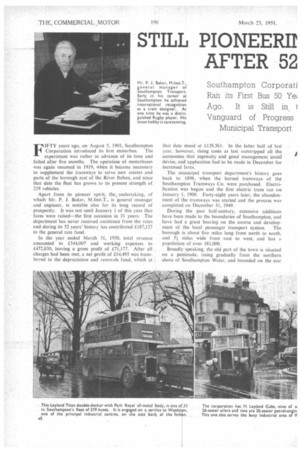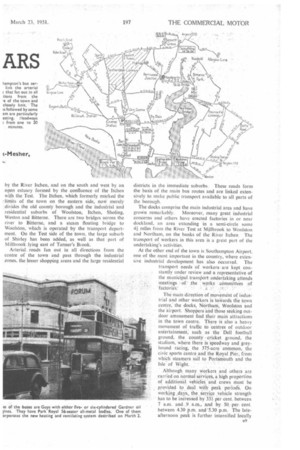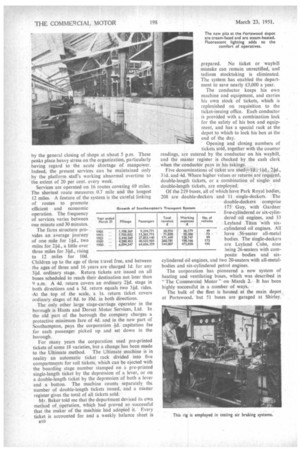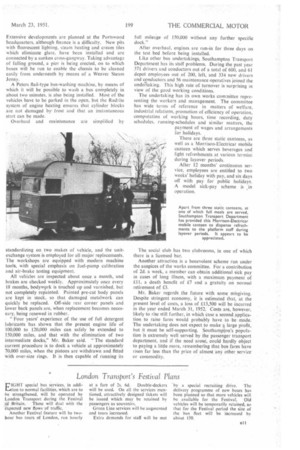STILL PIONEERIT AFTER 52 ARS
Page 42

Page 43

Page 44

Page 45

If you've noticed an error in this article please click here to report it so we can fix it.
FIFTY years ago, on August 5, 1901, Southampton
Corporation introduced its first motorbus. The experiment was rather in advance of its time and failed after five months. The operation of motorbuses was again resumed in 1919, When it became necessary to supplement the tramways to serve new estates and parts of the borough east of the River ltchen, and since that date the fleet has grown to its present strength of 219 vehicles.
Apart from its pioneer spirit, the, undertaking, of which Mr. P. J. Baker, M.Inst.T., is general manager and engineer, is notable also for its long record of prosperity. It was not until January 1 of this year that fares were raised—the first occasion in 31 years: The department has never received assistance from the rates and during its 52 years' history has contributed £187,127 to the general rate fund.
In the year ended March 31, 1950, total revenue amounted to £544,007 and working expenses to £472,830, leaving a gross profit of £71,177. After all , charges had been met, a net profit of £14,495 was transferred to the depreciation and renewals fund, which at that date stood at £128,561. In the latter half of last year, however, rising costs at last outstripped all the economies that ingenuity and good management could devise, and application had to be made in December for increased fares.
The municipal transport department's history goes back to 1898, when the horsed tramways of the Southampton Tramways Co. were purchased. Electrification was begun and the first electric tram ran on January 1, 1900. Forty-eight years later, the abandonment of the tramways was started and the process was completed on December 31, 1949.
During the pas( half-century, extensive additions have been made to the boundaries of Southampton, and have had a great bearing on the course and develop
ment of the. local passenger transport. system. The borough is about five miles long from north to south. and 51 miles wide from east to west, and has a population of over 181,000.
Broadly speaking, the old part of the town is situated on a peninsula, rising gradually from the northern shore of Southampton Water, and bounded on the east
by the River Itchen, and on the south and west by an open estuary formed by the confluence of the Itchen with the Test. The Itchen, which formerly marked the -limits of the town on the eastern side, now merely divides the old county borough and the industrial and residential suburbs of Woolston, Itchen, Sholing, Weston and Bitterne. There are two bridges across the river to Bitterne, and a steam floating bridge to Woolston, which is operated by the transport department. On the Test side of the town, the large suburb .01 Shirley has been added, as well as that .part of Millbrook lying east of Tanner's Brook.
Arterial_ roads fan out in all directions from the centre of the town and pass through the industrial zones, the lesser shopping areas and the large residential districts in the immediate suburbs. These roads form the basis of the main bus routes and are linked extensively to make public transport available to all parts of the borough.
The docks comprise the main industrial area and have grown remarkably. Moreover, many great industrial concerns and others have erected factories in or near dockland, an area extending in a semi-circle some 41 miles from the River Test at Millbrook to Woolston and Northam, on the banks of the River Itchen. The transport of workers in this area is a great part of the undertaking's activities.
At the other end of the town is Southampton Airport, one of the most important in the country, where extensive industrial development has also occurred. The transport needs of workersare kept constantly under review and -a representative of the municipal transPort .undertaking attends 'meetings of The • works .committees of factori8:
The main direction of movement of industrial and other workers is toWards the town centre; the docks, NOrthain, WoolstOn and the airport. ShopPers and those seeking outdoor amusement find their main attractions in the town centre. There is also a heavy movement of traffic to centres of outdoor entertainment; such as the Dell football ground, the county cricket ground, the stadium, where there is Speedway and greyhound racing, the 375-acre common, the civic sports centre and the Royal Pier, fiorri which steamers sail to Portsrnouth arid the Isle of Wight.
Although many Workers and others are carried on normal serviceS, a high proportion of additional. vehicles and Crews Must' be provided to deal withpeak periods. On working ,days,., the seryi,ce vehicle strength has to be increased by 331 per cent. between
7 a.m. and_ 9. and by, 50, per cent. between 4.30 p.m. and 530 p.m. The lateafternoon peak is further intensified locally n9
by the general closing of shops at about 5 p.m. These peaks place heavy stress on the organization, particularly having regard to the acute shortage of manpower. Indeed, the present services can be maintained only by the platform staff's working abnormal overtime to the extent of 20 per cent, every week.
Services are operated on 16 routes covering 69 miles. The shortest route measures 0.7 mile and the longest 12 miles. A feature of the system is the careful linking of routes to promote efficient and economic operation. The frequency of services varies between one minute and 30 minutes. The fares structure provides an average journey of one mile for lid., two miles for 2W., a little over three miles for 30., rising to 12 miles for 10d.
Children up to the age of three travel free, and between the ages of three and 16 years are charged Id. for any 3-id. ordinary stage. Return tickets are issued on all buses scheduled to reach their destination not later than 9 a.m. A 4d. return covers an ordinary 20. stage in both directions and a 5d. return equals two 30. rides. At the top of the scale, a Is. return ticket covers ordinary stages of 8d. to 10d. in both directions.
The only other large stage-carriage operator in the borough is Hants and Dorset Motor Services, Ltd. In . the old part of the borough the company charges a protective minimum fare of 4d. and in the new part of Southampton, pays the corporation id. capitation fee for each passenger picked up and set down in the borough.
For many years the corporation used pre-printed tickets of some 18 varieties, but a change has been made to the Ultimate method. The Ultimate machine is in reality an automatic ticket rack divided into five compartments for roll tickets, which can be ejected with the boarding stage number stamped on a pre-printed single-length ticket by the depression of a lever, or on a double-length ticket by the depression of both a lever and a button. The machine counts separately_ the number of double-length tickets issued, and a master register gives the total of all tickets sold.
Mr. Baker told me that the department devised its own method of, operation, which had proved so-successful that the maker of the machine }tad adopted it.' Every ticket is accounted for and a weekly balance sheet is
Year ended March 31 Mileage Passengers 1905 .. 1,108,369 9,294,771 1915 ..
1,703,032 13,265,715 1925 ..
2,444,269 27,853,140 1939 ..
4,280,453 10,533,959 1950 .. 6.094,547
64,656,359
prepared. No ticket or waybill mistake can remain unrectified, and tedious stocktaking is eliminated. The system has enabled the department to save nearly £3,000 a year.
The conductor keeps his own machine and equipment, and carries his own stock of tickets, which is replenished on requisition to the ticket-issuing office. Each conductor is provided with a combination lock for the safety of his box and equipment, and has a special rack at the depot to which to lock his box at the end of the day.
" Opening and closing numbers of tickets sold, together with the counter readings, are entered by the conductor on his waybill, and the master register is checked by the cash clerk when the conductor pays in his takings.
Five denominations of ticket are used—id,, lid., 20., 31d. and 4d. Where higher values or returns are required, double-length tickets, or a combination of singleand double-length tickets, are employed.
Of the 219 buses, all of which have Park Royal bodies, 208 are double-deckers and 11 . single-deckers. The double-deckers comprise 175Guy, with Gardner five-cylindered or six-cylindered oil engines, and 33 Leyland Titan with sixcylindered oil engines. All have 56-seater all-metal bodies. Thesingle-deckers are Leyland Cubs, nine being 26-seaters with corn
posite bodies and sixcylindered oil engines, and two 20-seaters with all-metalbodies and six-cylindered petrol engines.
The corporation has pioneered a new system of heating and ventilating buses, which was described in "The Commercial Motor" on March 2. It has been highly successful in a number of ways.
The bulk of the fleet is housed at the main depot at Portswood. but 51 buses are garaged at Shirley.
Total revenue i Working expenses I Na. of vehicles 50,916 36,179 49
71,038 50,306 -73
171,449 128,747 99
260,781 198,166 173
544,007 472,830 195
Extensive developments are planned at the Portswood headquarters, although finance is a difficulty. New pits with fluorescent lighting, steam heating and cream tiles which eliminate glare, have been installed and are connected by a sunken cross-gangway. Taking advantage of falling ground, a pier is being erected, on to which buses will he run to enable the chassis to be cleaned easily from underneath by means of a Weaver Steam Jenny.
A Peters flail-type bus-washing machine, by means of which it will be possible to wash a bus completely in about two minutes, is also being installed. Most of the vehicles have to be parked in the open, but the Radrite system of engine heating ensures that cylinder blocks are not damaged byfrost and that an instantaneous start can be made.
Overhaul and maintenance are simplified by standardizing on two makes of vehicle, and the unitexchange system is employed for all major replacements. The workshops are equipped with modern machine tools, with special emphasis on fuel-pump calibration and air-brake testing equipment.
All vehicles are inspected about once a month, and brakes are checked weekly. Approximately once every 18 months, bodywprk is touched up and varnished, but not completely repainted. Painted pre-cut body panels are kept in stock, so that damaged metalwork can quickly be replaced. Off-side rear corner panels and lower back panels are, when replacement becomes necessary, being renewed in rubber.
"Four years" experience of the use of full detergent lubricants has shown that the present engine life of 100,000 to 120,000 miles can safely be extended to 150,000 miles, and that with the elimination of two intermediate docks," Mr. Baker said. "The standard current procedure is to dock a vehicle at approximately 70,000 miles, when the pistons are withdrawn and fitted with over-size rings. It is then capable of running its full mileage of 150,000 without any further specific dock."
After overhaul, engines are run-in for three days on the test .bed before being installed.
Like other bus undertakings, Southampton Transport Department has its staff problems. During the past year 371 drivers and conductors out of a total of 600, and 61 depot employees out of 200, left, and 334 new drivers and conductors and 56 maintenance operatives joined the undenaking. This high rate of turnover is surprising in view of the good working conditions.
The undertaking has its own works committee representing the workers and management. The committee has wide terms of reference in matters of welfare, industrial relations, promotion of efficiency of operation, computation of working hours, time recording, duty schedules, running-schedules and similar matters, the payment of wages and arrangements for holidays.
There are three static canteens, as well as a Morrison-Electricar mobile canteen which serves beverages and light refreshments at various termini during layover periods.
After 12 months' continuous service, employees are entitled to two weeks' holiday with pay, and six days off with pay for public holidays.
A model sick-pay scheme is in operation.
1 he social club has two clubrooms, in one of which there is a licensed bar.
Another attraction is a benevolent scheme run under the auspices of the works committee. For a contribution of 2d. a week, a member can obtain additional sick pay in cases of long illness, with a maximum payment of £11, a death benefit of £7 and a gratuity on normal retirement of D.
Mr. Baker regards the future with some misgiving. Despite stringent economy, it is estimated that, at the present level of costs, a loss of £13,500 will be incurred in the year ended March 31, 1952: Costs are, however, likely to rise still further, in which case a second application to raise fares would probably have to be .made. The undertaking does not expect to make a large profit, but it must be self-supporting. Southampton's population is extremely well served by the passenger transport department, and if the need arose, could hardly object to paying a little more, remembering that bus fares have risen far less than the price of almost any other .service or commodity.




















































































